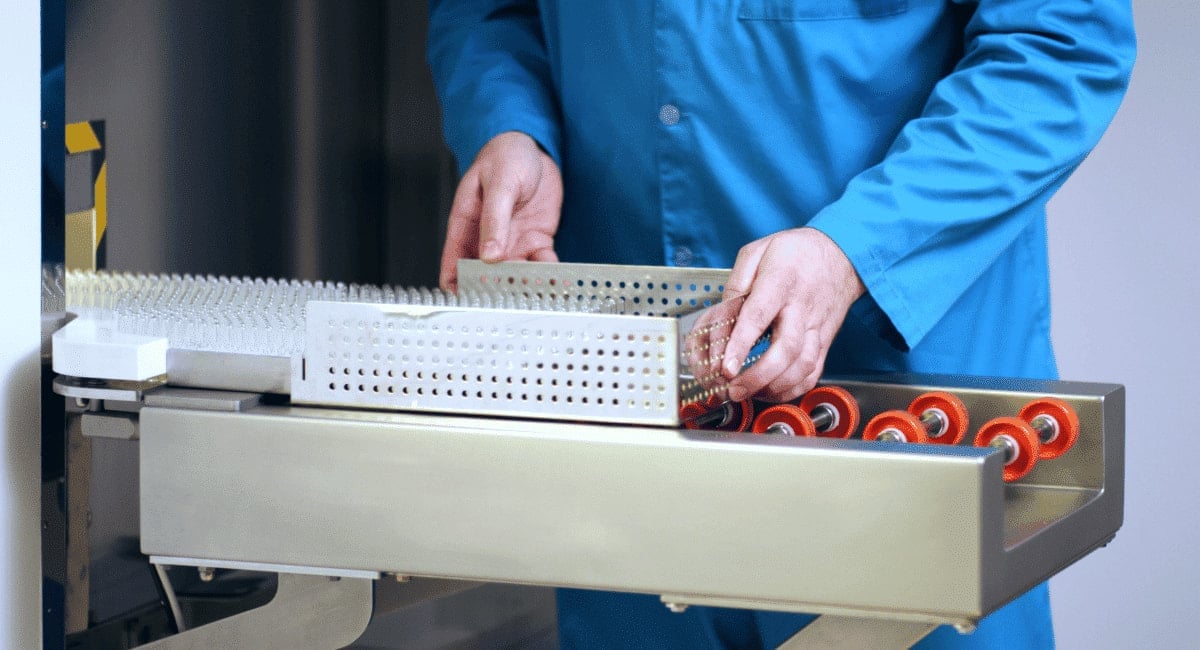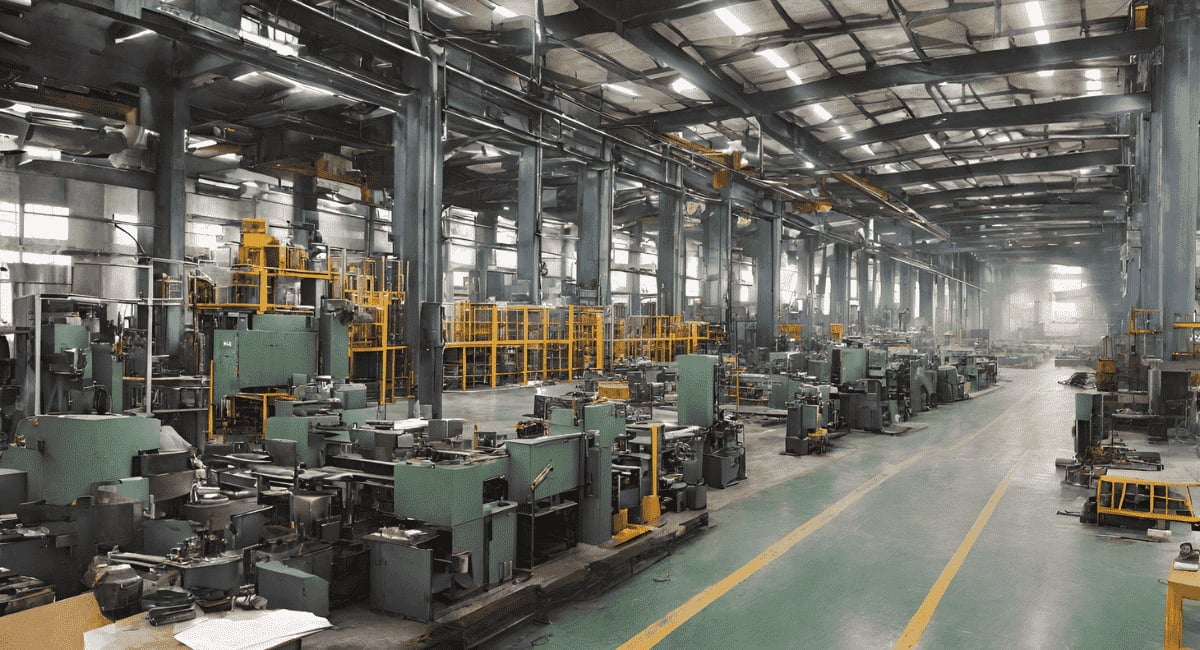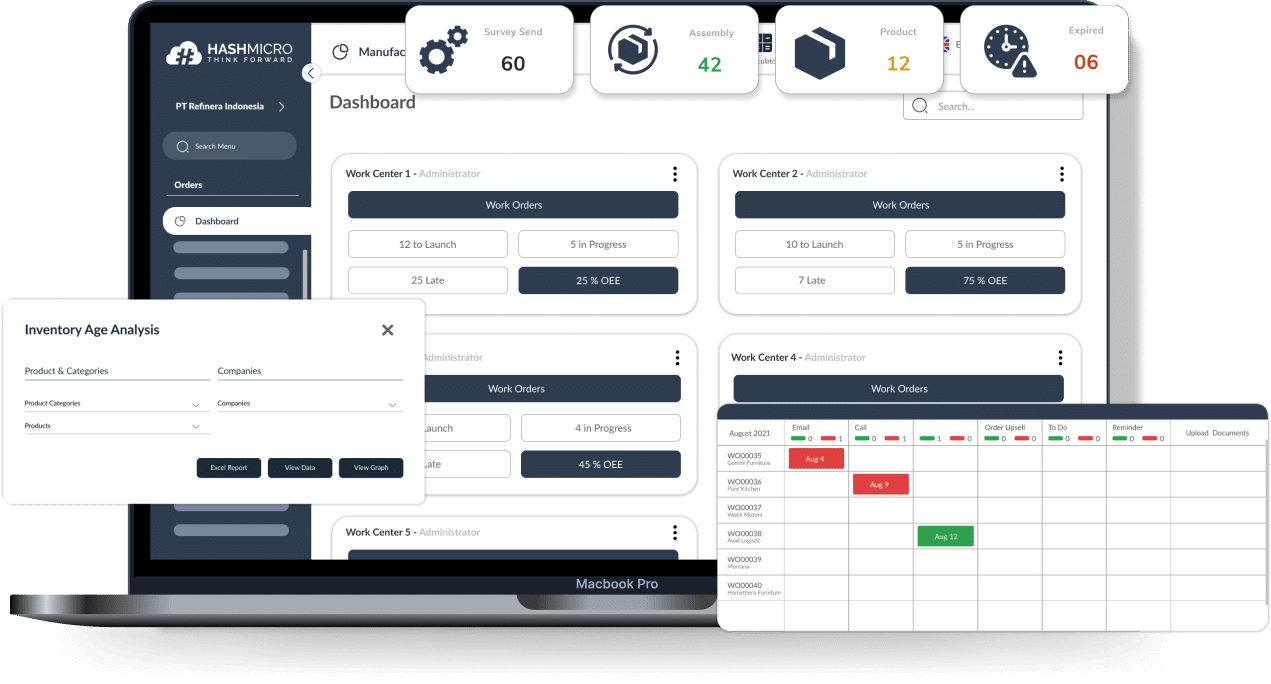In the competitive arena of manufacturing, where every second and every penny counts, the inability to harness the full power of data can be a silent killer for your business. Picture this: while you rely on traditional methods and gut feelings, your competitors are leveraging data to not only survive but thrive. This isn’t just about keeping up; it’s about not being left behind in a world where precision, speed, and efficiency are kings.
Every moment lost to inefficiency, every resource squandered due to lack of insight, eats into your profit margin. In the digital age, the failure to adopt advanced analytics could mean bidding farewell to opportunities that might never knock again. This fear is not unfounded, as the industry’s giants are already using these tools to make formidable strides.
But there’s a beacon of hope. Manufacturing analytics stands as the solution to cut through the chaos, providing clarity amidst a sea of data. With the help of manufacturing system, it turns raw numbers into actionable intelligence, aligning every gear and bolt in the vast machinery of manufacturing to the tune of productivity and profit.
Now, let’s explore the complete guide to manufacturing analytics.

Table of Content
What is Manufacturing Analytics?

Manufacturing analytics can be thought of as the high-tech compass for navigating the complex world of industrial production. It’s a process that involves the thorough examination and interpretation of data gathered from the many cogs in the manufacturing machine: from tiny sensors on the shop floor to the large-scale systems that manage supply chains. But what does this actually mean?
When we talk about manufacturing analytics, we’re discussing the smart use of data to polish the manufacturing process until it shines. It’s about taking a deep dive into the ‘what,’ ‘how,’ and ‘why’ of production. The data comes from everywhere — the humming machinery, the busy conveyor belts, and the web of logistics that brings materials in and sends products out.
This isn’t just about collecting numbers and facts. It’s about squeezing every drop of insight from that data through sophisticated methods like pattern recognition and predictive forecasting. Think of it as the manufacturing world’s version of detective work, where clues are hidden in the data, and solving the case means making the whole production process smoother, sharper, and smarter.
Imagine being able to see the invisible — to predict when a machine is going to falter before it even happens or to spot a way to make things run faster without compromising on quality. That’s the promise of manufacturing analytics: to illuminate the hidden potentials and pitfalls within the vast mechanisms of production.
But why is all this number-crunching and data sleuthing important? It takes us to the heart of why manufacturing analytics doesn’t just matter, it’s critical. This brings us to the next part of our discussion: The Importance of Manufacturing Analytics. Here, we will delve into how these insights not only steer individual companies toward better profits and productivity but also shape the entire manufacturing industry for the better.
Key Metrics of Manufacturing Analytics

Now, we’ll discover the key metrics that act as critical performance indicators, providing the visibility needed to make informed decisions, drive efficiency, and improve the bottom line. With these metrics, you’ll be able to measure success, pinpoint areas for improvement, and streamline your operations for optimal performance.
Overall Equipment Effectiveness (OEE)
Imagine you have a factory that makes widgets. You have machines that cut, shape, and inspect each widget before it gets sent to customers. To make sure everything runs smoothly and no time or materials are wasted, you use a special measuring stick called “Overall Equipment Effectiveness,” or OEE for short.
Think of OEE like a report card for your machines. It tells you how well they’re doing their job by looking at three important things: Availability, Performance and Quality. Below are the formulas to calculate each component.
- Availability: (Operating Time – Downtime) / Operating Time
- Performance: (Ideal Cycle Time x Total Count) / Operating Time
- Quality: Good Count / Total Count
Now, to figure out your machines’ OEE, you use a simple math formula:
| OEE: Availability x Performance x Quality |
For example, here’s how you do each one:
If Availability is 90%, Performance is 95%, and Quality is 99%, your OEE would be:
0.90 (Availability) x 0.95 (Performance) x 0.99 (Quality) = 0.845 or 84.5%
Using OEE helps you spot problems like why machines are down too often, not running fast enough, or making too many mistakes. By tracking OEE and making improvements, you can ensure your factory keeps humming along efficiently, making more widgets and wasting less time and material. It’s a neat way to keep your factory’s machines in top shape and your business booming.
To make it easier while calculating OEE, you can consider adopting a manufacturing system. This system can automate OEE calculations and make a comprehensive report.
Cycle Time
When you hear the term “Cycle Time” in the manufacturing world, think of it as the stopwatch time for your production process. It’s the measure of how long it takes to make one unit of whatever you’re making, from the moment you begin work on it to the moment it’s ready to go out the door.
So, why is Cycle Time such a big deal? Well, for starters, it’s like a pulse check for the health of your manufacturing floor. It tells you how long your machines and teams are spending on each product. If the time is too long, it might mean a jam somewhere in the process, like a tricky machine setup or a part that’s always running out. Finding and fixing these jams can make your whole operation run smoother and faster.
Now, let’s get into the nitty-gritty. To calculate the Cycle Time, you would look at the Operating Time, which is how long the machines were buzzing and workers were working, and then divide that by the Total Units Produced in that time.
Here’s the formula in a simple way:
| Cycle Time = Operating Time / Total Units Produced |
- Operating Time: This is the total time the production line was making things. It’s like the “on” time when everything is moving.
- Total Units Produced: This is how many finished products you got at the end of that operating time.
For example, if your Operating Time was 8 hours (or 480 minutes) and you produced 240 units in that time, your Cycle Time would be: 480 minutes / 240 units = 2 minutes per unit.
Now, to get even more detailed, you can break Cycle Time down into smaller bits like setup time (getting the machines ready), processing time (the actual making of the product), and wait time (when things are on hold, like waiting for materials). By looking at these pieces, you can pinpoint exactly where you might be losing time.

Throughput
Throughput is like the speedometer for your factory’s production line. It measures how much product your system is cranking out over a certain period of time. Think of it as a way to gauge the flow rate of your production pipe – how many goods are flowing out the door.
Why pay attention to Throughput? Because it’s all about getting the most bang for your buck. If you know how many items you’re producing within a certain time, you can tell if you’re really getting the most out of your machines and people, or if there’s a hiccup somewhere slowing things down.
Here’s the simple formula to calculate Throughput:
| Throughput = Total Units Produced / Processing Time |
- Total Units Produced: This is the count of everything you’ve made in the given time, the whole batch of goods.
- Processing Time: This is the amount of time from when you start making something to when you finish. It includes all the nitty-gritty like setting up machines and the actual run time.
So, if your team produced 500 widgets over 10 hours, your Throughput would be:
500 widgets / 10 hours = 50 widgets per hour.
Boosting your Throughput means you’re making the system more efficient. Maybe you streamline some steps so that things move faster, or you cut out downtime so that machines keep running smoothly. The faster goods come out without compromising on quality, the more you can sell, and the happier your customers are – it’s a win-win!
Quality Yield
Quality Yield in manufacturing is a bit like a report card for your production line, showing you how much of what you made was up to the mark. It’s a tally of the products that pass your quality checks versus everything that came off the line, whether good or bad.
Here’s why Quality Yield matters: It’s a clear indicator of how well your production process is doing at making things right the first time. High-quality yield means fewer do-overs and less waste, which is good for both the planet and your pocket.
Now, how do you figure out your Quality Yield? It’s pretty straightforward:
| Quality Yield = (Total Units Produced – Defective Units) / Total Units Produced |
- Total Units Produced: This number is all the items you made in a set period – the whole shebang.
- Defective Units: These are the pieces that didn’t make the cut because they didn’t meet your quality standards.
Defect Rate
Defect Rate is all about spotting the slips and misses in your manufacturing process. It’s like a magnifying glass that zooms in on the number of items that didn’t quite hit the quality mark. Understanding this rate is crucial because it’s not just about how many items you’re churning out, but how many of those are actually good to go.
Think of Defect Rate as your factory’s accuracy rate. It answers the question: “Out of everything we make, what percentage isn’t up to snuff?”
Here’s how to crunch those numbers:
| Defect Rate = (Defective Units / Total Units Produced) x 100% |
- Total Units Produced: Count up everything that’s come off your production line in a certain time frame.
- Defective Units: These are the ones that didn’t meet your quality checklist.
Inventory Turns
“Inventory Turns” might sound a bit technical, but it’s actually a straightforward concept that tells us a lot about the health of a manufacturing business. In simple terms, it’s about how often a company goes through its entire stock of goods within a particular period.
Think about it as the number of times a store could empty and refill its shelves over a year. A store that sells out and restocks more often is like a speedy runner—it means business is brisk, and products aren’t gathering dust.
Here’s the easy-peasy formula to figure out your Inventory Turns:
| Inventory Turns = Cost of Goods Sold / Average Inventory |
Let’s break that down:
- Cost of Goods Sold (COGS): This is how much you’ve spent on the goods you’ve sold in a set time period.
- Average Inventory: This one’s the average value of the stuff you’ve had on hand during that same time.
Why does this matter? Knowing your Inventory Turns can give you insights on how to manage your stock better. A high number could mean you’re selling stuff faster than hotcakes, which is great! But if it’s too high, you might run the risk of empty shelves and unhappy customers.
Lead Time
When you order something online, you’re usually keen to know how soon it will arrive, right? This is where “Lead Time” comes into play, and it’s crucial for businesses too, especially those making and selling products.
In the manufacturing world, Lead Time is all about timing—from the moment an order is placed all the way to delivery at the customer’s doorstep. It’s a big deal because it tells you how quick a business is at getting products out the door and into customers’ hands.
Here’s how you can think about it: If you were timing a relay race, Lead Time would be the total time from the starting gun (when the order is received) to when the baton is passed across the finish line (the product is delivered to the customer).
So, how do we calculate it? Here’s the formula that’ll do the trick:
| Lead Time = Manufacturing Lead Time + Delivery Lead Time |
Let’s decode this formula:
- Manufacturing Lead Time: This is the time taken from when an order is placed until the finished product is ready to ship. Imagine it’s like the time it takes to bake a cake—from mixing the ingredients to taking it out of the oven.
- Delivery Lead Time: This is the time it takes to get the product from the factory to the customer’s location. Think of it like the time it takes to deliver the cake to the birthday party.
If a business knows its Lead Time, it can make promises to customers that it knows it can keep. For example, if a toy manufacturer has a Lead Time of 2 weeks, they can confidently tell their customers that orders will arrive in that time frame.
Capacity Utilization
Think of a factory like a busy kitchen. Just like chefs use ovens and stovetops to whip up meals, factories use machines and workers to create products. Now, how well this kitchen uses its ovens and space is super important. If there’s an oven that’s always off, that’s a bit of a waste, right? This is where “Capacity Utilization” comes into the picture in the manufacturing world. It’s all about how much of the ‘kitchen’ is cooking!
Capacity Utilization shows how much a factory is producing compared to what it could if it were using all its ‘ovens’ at full blast. Here’s a simple formula to figure it out:
| Capacity Utilization = (Actual Output / Potential Output) x 100% |
Why is this number important? Well, it helps businesses figure out if they’re getting the most out of their factories. If the number is low, they might be spending money on space and machines they don’t need. If it’s too high, they could be pushing too hard, which might lead to machines breaking down or workers getting too stressed.
Downtime
Just like a car, your machinery needs pit stops. That’s what downtime is all about – it’s the time when your factory machines take a break, either for a quick fix or because something unexpected happened.
Think of downtime like a stop clock. It ticks away the minutes and hours when your machines aren’t humming and churning out products. Here’s a simple way to keep track of it:
| Downtime = Planned Downtime + Unplanned Downtime |
Why should we keep our eyes on downtime? Well, every minute your machines aren’t working, you’re not making your products. If there’s too much downtime, your factory isn’t making as much as it could, and that could mean fewer toys for kids, fewer phones for tech lovers, or fewer cookies for snack time – depending on what you’re making.
Benefits of Manufacturing Analytics

So, let’s advance and unveil the multitude of benefits that manufacturing analytics can provide, understanding how they serve as the building blocks for enhanced performance, innovation, and strategic success in the manufacturing industry.
Better Decision-Making
Manufacturing analytics is transforming the way factories and production lines operate, making the entire process smarter and more efficient. One of the standout advantages of this high-tech tool is the power it gives manufacturers to make better decisions. Let’s break down how it does just that.
Imagine having a crystal ball that lets you peek into every aspect of your manufacturing process – that’s what analytics offers. It takes a deep dive into the data that runs through the veins of manufacturing operations: how products are made, where supplies come from, and what your customers think about what you’re selling.
For instance, think about the way we shop. Sometimes we want more of something, and at other times less. Manufacturers can now spot these changes in shopping patterns faster than ever. With analytics, they can fine-tune how much they produce to keep up with what we want, which means no more mountains of unsold items and a happier planet because of less waste.
Then there’s the journey of all those parts and pieces needed to make a product. It can get complicated, like a big puzzle where the pieces have to arrive just at the right time. Manufacturing analytics is like the border pieces of that puzzle, helping businesses figure out the best way to bring everything together smoothly and at the lowest cost.
Improved Resource Utilisation
Manufacturing analytics is like having a superpower that allows factories to use their resources – materials, machines, and manpower – in the smartest possible way. Let’s explore how it does this, under the banner of improved resource utilization.
First up, imagine a juggler with a never-ending stream of balls in the air. That juggler is like a manufacturer trying to keep all parts of the production process in perfect harmony. With manufacturing analytics, the juggler gets an extra pair of eyes, helping them see which balls (or resources) are likely to fall and which are underused. This means they can make quick adjustments to keep the show running without a hitch.
Materials are the bread and butter of any product. Too much, and you’ve got wastage; too little, and production grinds to a halt. Manufacturing analytics acts like a master chef who knows exactly how much bread and butter is needed for the perfect sandwich – it helps manufacturers order and use materials just right, so nothing goes to waste.
Next, let’s talk about the machines that do the heavy lifting. These machines work tirelessly, but they don’t have to work all the time. Manufacturing analytics is like a thoughtful coach that can spot the best times for the machines to run and when they can take a well-deserved break, making sure they’re used at their peak potential without wearing them out.
Lastly, the people who make everything happen – the workforce. Manufacturing analytics can help make sure that every person’s skills are used where they shine the brightest, at the times when they’re needed the most. It’s like creating a perfect schedule for a team where everyone plays their part without any energy or talent going to waste.

Increased Customer Satisfaction
Think of a business like a chef in a popular restaurant. The chef’s goal is to make sure every dish that comes out of the kitchen is so delicious that customers keep coming back for more. In the manufacturing world, analytics is the secret ingredient that helps businesses ensure every product they make hits the mark on quality every single time. This consistency is what makes customers trust a brand and stay loyal.
But it’s not just about quality. It’s also about getting your order served up on time – no one likes waiting too long for their meal, right? Manufacturing analytics helps companies become like the most efficient restaurants, where your food arrives just when you’re expecting it. This precision in delivering orders when promised goes a long way in keeping customers happy and coming back.
Now, imagine the waiter who remembers your name and your favorite dish. Manufacturing analytics allows businesses to be that waiter, helping them understand and remember what each customer likes, which can make customers feel special and valued. That’s the kind of service that turns a one-time buyer into a lifelong fan.
In essence, manufacturing analytics helps companies make better, faster, and smarter decisions about how to meet their customers’ needs and exceed their expectations. Happy customers are likely to tell their friends about their great experiences, leading to more business and, ultimately, a healthier bottom line for companies.
Cost Reduction
By looking closely at the data from how things are made, how supplies get in, and how much is spent, companies can spot where they’re losing money and patch things up. This might mean fixing a step in the making of a product that’s creating too much scrap, or changing the setup of machines to make them run faster and smoother.
It’s a bit like planning the most efficient route for a road trip. You wouldn’t want to drive in circles or take a longer path if there’s a shortcut. Analytics does this for manufacturers. It helps plan out production so everything runs on the straightest, fastest route, saving time and fuel—or in the factory’s case, money.
And then there’s the whole maze of getting materials to the factory and shipping products out. With analytics, manufacturers can find the fastest, cheapest way to move stuff around. This might mean storing less because they can get supplies just in time, or finding better shipping routes that cost less money.
By using manufacturing analytics, businesses can not only keep more money in their pockets but also become more efficient and competitive.
Predictive Maintenance
Manufacturing analytics has made significant strides in enhancing maintenance strategies with the implementation of predictive maintenance. This analytical approach allows for the anticipation of equipment failure, ensuring that maintenance can be conducted in a timely, pre-emptive manner rather than in response to a breakdown.
The process involves constant monitoring of equipment through sensors that track various parameters such as temperature, vibration, and noise. These sensors generate a wealth of data that, when analyzed, can identify patterns or anomalies indicating that a piece of equipment is heading toward a malfunction.
This capability to predict a problem before it occurs has several tangible benefits. It minimizes equipment downtime, as maintenance work is scheduled before a failure can interrupt production. In turn, this reduces the financial strain caused by unplanned stoppages and the rush to make emergency repairs.
Furthermore, by preventing the full breakdown of machines, predictive maintenance extends the overall lifespan of the equipment. Regular, data-driven upkeep prevents excessive wear and tear since issues are addressed before they can escalate into major faults.
Streamline Manufacturing Analytics with HashMicro Manufacturing Software

If you’re on the lookout for a system that will not only automate your manufacturing analytics but also fine-tune your entire production process, HashMicro provides the right solution for you. Its state-of-the-art manufacturing software is engineered to bring precision, efficiency, and simplicity to your operations, propelling your business toward a future of growth and innovation.
Automatic WIP Calculations
Work-In-Process (WIP) calculations are vital for accurate inventory assessments and financial reporting. HashMicro simplifies this complex process with automation, eliminating manual errors and saving valuable time. With real-time WIP data at your fingertips, decision-making becomes more informed and strategic.
Timely Production Activities
The key to maintaining a competitive edge is the ability to execute production activities promptly and efficiently. HashMicro’s software helps orchestrate production workflows, ensuring that every step from planning to execution is timed perfectly and resources are used optimally. This synchronicity in production processes not only boosts productivity but also enhances the timeliness of product delivery.
Controlled Inventory and Procurement
Inventory management can make or break a manufacturing operation. HashMicro’s solution offers precise control over inventory levels, reducing the likelihood of overstocking or stockouts. Coupled with a robust procurement module, the software ensures that you purchase the right materials at the right time, optimizing inventory turnover and cost efficiency.
Comprehensive Reports
Data is only as good as the insights drawn from it. HashMicro’s manufacturing software comes equipped with comprehensive reporting capabilities, offering deep dives into every facet of your manufacturing process. These insights empower businesses to pinpoint inefficiencies, forecast trends, and align their operations with their strategic goals.
Multi-level Bill of Materials (BOM)
Complex products require a detailed breakdown of components, and HashMicro’s multi-level BOM feature handles this complexity with ease. It allows for an intricate mapping of all parts and materials needed at every stage of the manufacturing process, enhancing accuracy in costing and ensuring every component is accounted for.
ERP and IoT Integration
At the heart of HashMicro’s effectiveness is its ability to integrate with ERP systems and IoT devices. This connectivity enables a seamless flow of information across different areas of the business, from the factory floor to the financial department. IoT integration further enhances this by feeding real-time data from machines and sensors into the system for immediate analysis and action.
In summary, HashMicro’s Manufacturing Software isn’t just a tool; it’s a game-changer for manufacturers aiming to harness the power of analytics and propel their business forward in a competitive marketplace.
Conclusion
In conclusion, the world of manufacturing is evolving at an unprecedented pace, and at the core of this transformation is manufacturing analytics. With the power to convert vast amounts of raw data into strategic insights, these analytics allow businesses to not only keep pace with industry advancements but also stay ahead of the curve.
The importance of such analytics cannot be overstated; they are the linchpin in creating more efficient production lines, reducing waste, improving quality, and satisfying customer demands with precision and reliability.

For those ready to embark on this journey, HashMicro’s Manufacturing Software offers a gateway to advanced analytics. With its robust features and intuitive interface, HashMicro is more than just a software provider—it’s a partner in innovation. The platform is designed to integrate seamlessly into your operations, turning complexity into clarity and data into decisions. Try the free demo now, and claim 50% discount with EDG.













